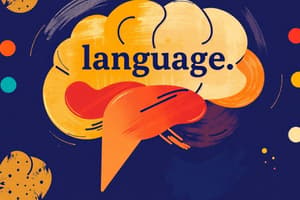Podcast
Questions and Answers
What can language be defined as?
What can language be defined as?
What are the three criteria for language?
What are the three criteria for language?
Semanticity, Generativity, Displacement
Semanticity refers to the ability to combine words meaningfully in language.
Semanticity refers to the ability to combine words meaningfully in language.
False
What does generativity allow us to do?
What does generativity allow us to do?
Signup and view all the answers
What does displacement refer to in terms of language?
What does displacement refer to in terms of language?
Signup and view all the answers
What is linguistics?
What is linguistics?
Signup and view all the answers
What are phonemes?
What are phonemes?
Signup and view all the answers
What are morphemes?
What are morphemes?
Signup and view all the answers
The study of rules that govern the patterns of sounds in language is called ______.
The study of rules that govern the patterns of sounds in language is called ______.
Signup and view all the answers
What do bound morphemes do?
What do bound morphemes do?
Signup and view all the answers
What is semantics in relation to language?
What is semantics in relation to language?
Signup and view all the answers
Study Notes
Definition of Language
- Language is a socially agreed-upon system of arbitrary symbols utilized for communication of ideas and feelings.
- It involves rules that allow for the combination of symbols in various ways to convey meaning, applicable to both present and imagined contexts.
- To qualify as a language in psychology, criteria include:
- Semanticity
- Generativity
- Displacement
The Three Criteria: Semanticity
- Semanticity measures the capacity of communication to represent ideas, events, and objects meaningfully.
- It emphasizes the importance of discrete meanings assigned to symbols or signals.
- Higher semanticity correlates with the ability to convey a broader range of communication, exemplified by comparisons from honeybee dances to human language.
- Vervet monkeys exhibit semanticity through distinct calls with specific meanings.
The Three Criteria: Generativity
- Generativity refers to the capacity to combine words and symbols using syntactical rules to express a nearly infinite array of ideas from a limited vocabulary.
- It facilitates the creation of complex ideas surpassing the meanings of individual words.
- Music illustrates generativity through complex compositions, although it does not convey discrete meanings like language.
The Three Criteria: Displacement
- Displacement allows communication about events or concepts not present in the immediate context, including discussions about past or future occurrences.
- It enables reminiscing about past experiences, showcasing a hallmark of human language capability.
Linguistics
- Linguistics encompasses the study of language rules.
- Psycholinguistics is a subfield focused on language acquisition, comprehension, and production within cognitive psychology.
Phonology and Phonemes
- Phonology involves the rules regulating sound patterns within a language.
- Phonemes are the basic, distinguishable units of sound critical for differentiating words (e.g., "rice" vs. "lice").
- Phonemes are distinct from letters, as not all languages recognize the same differentiated sounds, illustrated by the Japanese phonological system.
Morphology and Morphemes
- Morphemes are combinations of phonemes that represent the smallest meaningful units of language.
- Morphology studies how morphemes are structured and combined.
- Types of morphemes:
- Free Morphemes: Standalone words with meaning (e.g., "book").
- Bound Morphemes: Meaningful only when attached to other morphemes, altering the base meaning (e.g., "engagement" consists of "engage" and "-ment").
Semantics, Syntax, and Pragmatics
- Semantics pertains to the meanings assigned to words and the rules governing these meanings, addressing the relationship between words and their significance.
Studying That Suits You
Use AI to generate personalized quizzes and flashcards to suit your learning preferences.
Description
Explore the foundational concepts of language as defined in PSYC 100B. This quiz focuses on understanding language as a socially constructed system of symbols and rules used for communication. Ideal for reinforcing key ideas in cognitive psychology.




